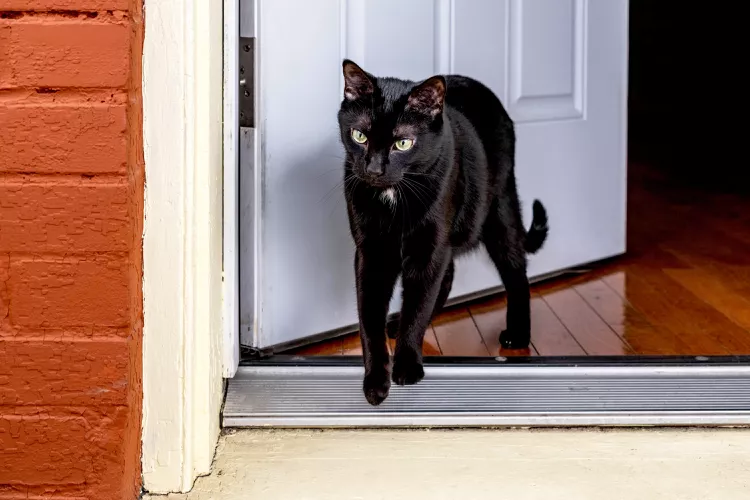How to Stop Your Cat From Escaping

Indoor cats sometimes attempt to escape out of the house, and this can be especially frightening for their owners. Most house cats are not at all equipped to handle the sensory overload of being outside and come back inside immediately, but if your house cat gets out, they run the greatest risk of injuring themselves (or being injured by another cat, person, or car).
Below, we explain why your cat might be trying to escape and get outside, solutions to avoid them escaping, and the best ways to protect your cat from external threats.
Why Do Cats Try to Escape?
Cats in the wild are natural hunters, who stalk their prey, kill it, eat it, and then return to the pride. They are also semi-nocturnal creatures who have a strong drive to reproduce. Lions especially are very territorial, fiercely protecting their turf and their young from any would-be interlopers.
Even though house cats have their meals provided to them, they still have the hunting urge and may try to get out to look for prey. House cats also still have the genetic urge to protect their territory and to get out and mate if they can. This is why they'll sometimes "mark" an area in the house by spraying urine. Keep in mind that in your cat's mind, its territory may extend beyond the house, especially if there are other cats in the neighborhood or if your cat has a particularly good view of the outdoors. Cats also like to keep apprised of their environment and be aware of potential dangers in and around their homes.
How to Stop Cats From Escaping
It's instinct for your house cat to want to explore and seek out the best view of its territory, even that seen through the window and blocked by an inconvenient door. You cannot change this instinct, but you can modify some of these irksome behaviors.
Make the Escape Route Unpleasant
Encourage your cat to stay away from danger zones with a few basic training techniques. Any time you see the cat lounging near the doorway, use an interruption such as a loud "SSST!" or clapped hands to shoo it away.
The idea is to make the doorway area unappealing so that kitty avoids it and offer a more rewarding pastime.
Many cats dislike the feeling and sound of walking on aluminum foil, so place a couple of sheets over the walkway if possible.
Another option is to apply Sticky Paws (double-sided tape) to make the surface uncomfortable. Put the Sticky Paws on placemats positioned on the forbidden area so it's easily removed. You can also use clear plastic floor mats placed spike-side up so the cat will avoid the area.
SSSCat is a cat repellent that has a built-in motion detector. When your cat approaches, the device sprays a hiss of air to startle the animal, who will likely retreat. You don't have to be present or near the product for it to work.
You may also use smell deterrents to keep the cat away from forbidden doorway zones. Cats dislike citrus smells, so orange or lemon scents sprayed at the bottom of the door may help.
Offer Alternative Getaway Options
It's not fair to simply forbid the cat access to a much-loved activity. Provide some allowed outlets that are more attractive than the forbidden zones, and it will naturally choose to lounge there and abandon the doorway dash.
Position a cat tree or kitty bed on a tabletop right in front of a window some distance away from the forbidden door. Make this the most wonderful cat lounge spot ever by hiding catnip or food treats in the bed, for example.
Before you go out the door, use positive reinforcement by giving your cat the "best treat in the world," but only if it's on the cat tree/bed (a safe distance from the door). Then make your exit. Enlist help from friends to knock on the door or ring the doorbell to practice, so arrivals also make kitty think, "Hey, it's treat time!"
Spay or Neuter Your Cat
While sterilizing it may not alleviate all of your cat's desire to sneak out, unaltered cats (those not spayed or neutered) make escape attempts much more often. Up to 90% of cats will see a reduction in their desire to escape and go roaming after they are spayed or neutered.
Protect Your Cat
If all else fails and your cat still tries to get out despite your best efforts, take some precautions to make sure it doesn't injure itself if it does escape.
- Have your cat wear a collar and a tag with your address on it at all times. For your cat's safety, this should be a tear-away collar so they can get away if the collar gets stuck on something. Because the collar may come off, you should also have your cat microchipped so that your cat can be identified with or without its tags.
- Put a sign by your cat's favorite door warning visitors to keep an eye out and close the door quickly behind them.
- Keep its vaccinations up to date and give it regular antiflea and heartworm medications.